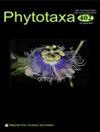Molecular phylogeny and morphology reveal a new wood-inhabiting fungal species, Hyphoderma guangdongense (Polyporales, Basidiomycota), from China
IF 1
4区 生物学
Q3 PLANT SCIENCES
引用次数: 0
Abstract
Hyphoderma is one of the most important representative groups of wood-inhabiting fungi. These fungi secrete various enzymes capable of degrading cellulose, hemicellulose, and lignin into simple inorganic substances. The taxa within the genus cause the white rot of wood, play a key role in the carbon cycle, and are the most efficient wood decomposers in the forest ecosystem. This study proposes a new wood-inhabiting fungal taxon, Hyphoderma guangdongense, based on morphological features and molecular evidence. It is characterized by the white hymenial surface, a monomitic hyphal system having the generative hyphae with clamp connections, the presence of the septate and tubular cystidia, and cylindrical basidiospores (6–10 × 3–5 µm). The phylogenetic tree inferred from a combination of the internal transcribed spacers (ITS) and large subunit (nrLSU) of the nuclear ribosomal DNA (rDNA) sequences revealed that H. guangdongense placed into the genus Hyphoderma, in which it is closely related to a clade comprising two taxa, H. setigerum, and H. floccosum. A full description, illustrations, and results of the new species' phylogenetic analysis are provided.分子系统发育和形态学揭示了中国一种栖息于林木中的真菌新种--Hyphoderma guangdongense(多孔菌目,担子菌科)。
真菌是栖息在木材中的真菌中最重要的代表类群之一。这些真菌能分泌各种酶,将纤维素、半纤维素和木质素降解成简单的无机物。该属的类群会导致木材白腐,在碳循环中扮演重要角色,是森林生态系统中最有效的木材分解者。本研究根据形态特征和分子证据,提出了一个新的木材栖息真菌类群--广东白腐菌(Hyphoderma guangdongense)。其特征是菌膜表面为白色,单生菌丝系统中的生成菌丝具有钳状连接,存在隔膜和管状子囊孢子,基生孢子为圆柱形(6-10 × 3-5 µm)。根据核糖体 DNA(rDNA)序列的内部转录间隔(ITS)和大亚基(nrLSU)组合推断出的系统发生树显示,广东鸡冠花被归入鸡冠花属(Hyphoderma),与由 H. setigerum 和 H. floccosum 两个类群组成的支系关系密切。本文提供了对该新种的完整描述、图解和系统发育分析结果。
本文章由计算机程序翻译,如有差异,请以英文原文为准。
求助全文
约1分钟内获得全文
求助全文
来源期刊

Phytotaxa
PLANT SCIENCES-
CiteScore
1.90
自引率
27.30%
发文量
956
审稿时长
1 months
期刊介绍:
Phytotaxa is a peer-reviewed, international journal for rapid publication of high quality papers on any aspect of systematic and taxonomic botany, with a preference for large taxonomic works such as monographs, floras, revisions and evolutionary studies and descriptions of new taxa. Phytotaxa covers all groups covered by the International Code of Nomenclature foralgae, fungi, and plants ICNafp (fungi, lichens, algae, diatoms, mosses, liverworts, hornworts, and vascular plants), both living and fossil. Phytotaxa was founded in 2009 as botanical sister journal to Zootaxa. It has a large editorial board, who are running this journal on a voluntary basis, and it is published by Magnolia Press (Auckland , New Zealand). It is also indexed by SCIE, JCR and Biosis.
All types of taxonomic, floristic and phytogeographic papers are considered, including theoretical papers and methodology, systematics and phylogeny, monographs, revisions and reviews, catalogues, biographies and bibliographies, history of botanical explorations, identification guides, floras, analyses of characters, phylogenetic studies and phytogeography, descriptions of taxa, typification and nomenclatural papers. Monographs and other long manuscripts (of 60 printed pages or more) can be published as books, which will receive an ISBN number as well as being part of the Phytotaxa series.
 求助内容:
求助内容: 应助结果提醒方式:
应助结果提醒方式:


